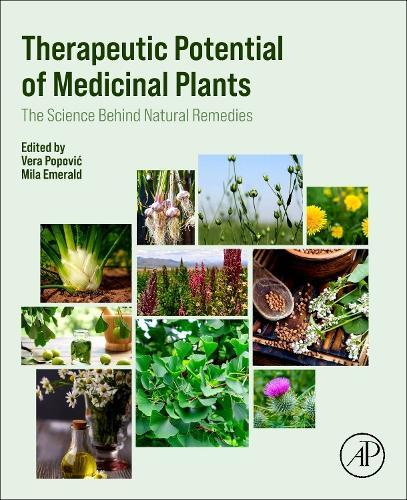Overview
When synthetic drugs produce adverse side effects, practitioners may look to natural alternatives to alleviate symptoms or complement existing treatment. Therapeutic Potential of Medicinal Plants: The Science Behind Natural Remedies, investigates the bioactive compounds and functionality of medicinal plants and herbs which are recommended to help certain health conditions and overall well-being while highlighting cultivation that can be done sustainably to promote biodiversity conservation. Written by over 50 experts in the fields of nutrition, organic food, fertility, phytopharmacology, biotechnology, nanotechnology, plant botanicals, and herbal medicine, “Therapeutic Potential of Medicinal Plants: The Science Behind Natural Remedies,” introduces readers to the the chemical composition of over 75 plants, herbs, grains and seeds while highlighting their anti-inflammatory, antimicrobial, antioxidant, and immunomodulatory effects to improve overall well being and manage certain conditions such as diabetes, osteoarthritis, cardiovascular and neurodegenerative diseases. Bioactive compounds, essential oils and phytochemicals in certain plants and marine compounds are reviewed for their efficacy to help improve gynecological health, alleviate menopausal symptoms and lower blood pressure. The book also discusses the toxicity and safety implications associated with the use of medicinal herbs during pregnancy and other life stages.
Full Product Details
Author: Vera Popović, PhD (Institute of Field and Vegetable Crops, Serbia) ,
Mila Emerald, PhD (Phytoceuticals International, Canada)
Publisher: Elsevier Science Publishing Co Inc
Imprint: Academic Press Inc
Weight: 0.450kg
ISBN: 9780443331527
ISBN 10: 0443331529
Pages: 600
Publication Date: 01 November 2025
Audience:
Professional and scholarly
,
Professional & Vocational
Format: Paperback
Publisher's Status: Forthcoming
Availability: Not yet available

This item is yet to be released. You can pre-order this item and we will dispatch it to you upon its release.
Author Information
Prof. Dr. Vera Popovic currently works at the Department оf Vegetable and Alternative Crops, in Institute of Field and Vegetable Crops, Novi Sad, Serbia. Vera does research in Agronomy, Nutrition, Agricultural Economics and Agricultural Plant Science in Conventional and Organic Cropping System, Biology and Biochemistry. Their current project is 'Alternative cereals and oil crops as a source of healthcare food and an important raw material for the production of biofuel'. Prof. Mila Emerald, Ph.D., Dr. Sc., President and CEO at PHYTOCEUTICALS International ™ & NOVOTEK Global Solutions ™, Ph.D. in Cellular Biochemistry and Molecular Biophysics, Dr. Science in Neuroscience, and professorship from the Cornell University, dedicated her life to research of nutraceuticals and natural products, their therapeutic properties, and applications. Her work, business, and research are dedicated to the role of natural nanomaterials and novel drugs delivery systems, in nutraceuticals, fermented products, functional foods, probiotics, essential oils and natural extracts complexes, and their crucial role in human wellbeing and health. She is also focused on the natural compounds, which can potentially be used in prevention and maintenance of bacterial, fungal, as well as viral pathogens, including SARS-COV2. Dr. M. Emerald is honoured to be one of the winners in the International Challenge called: “Next Great Impossible on Nanotechnology, by Sigma-Aldrich/Merck, one of the most viewed profiles on the LinkedIn.



